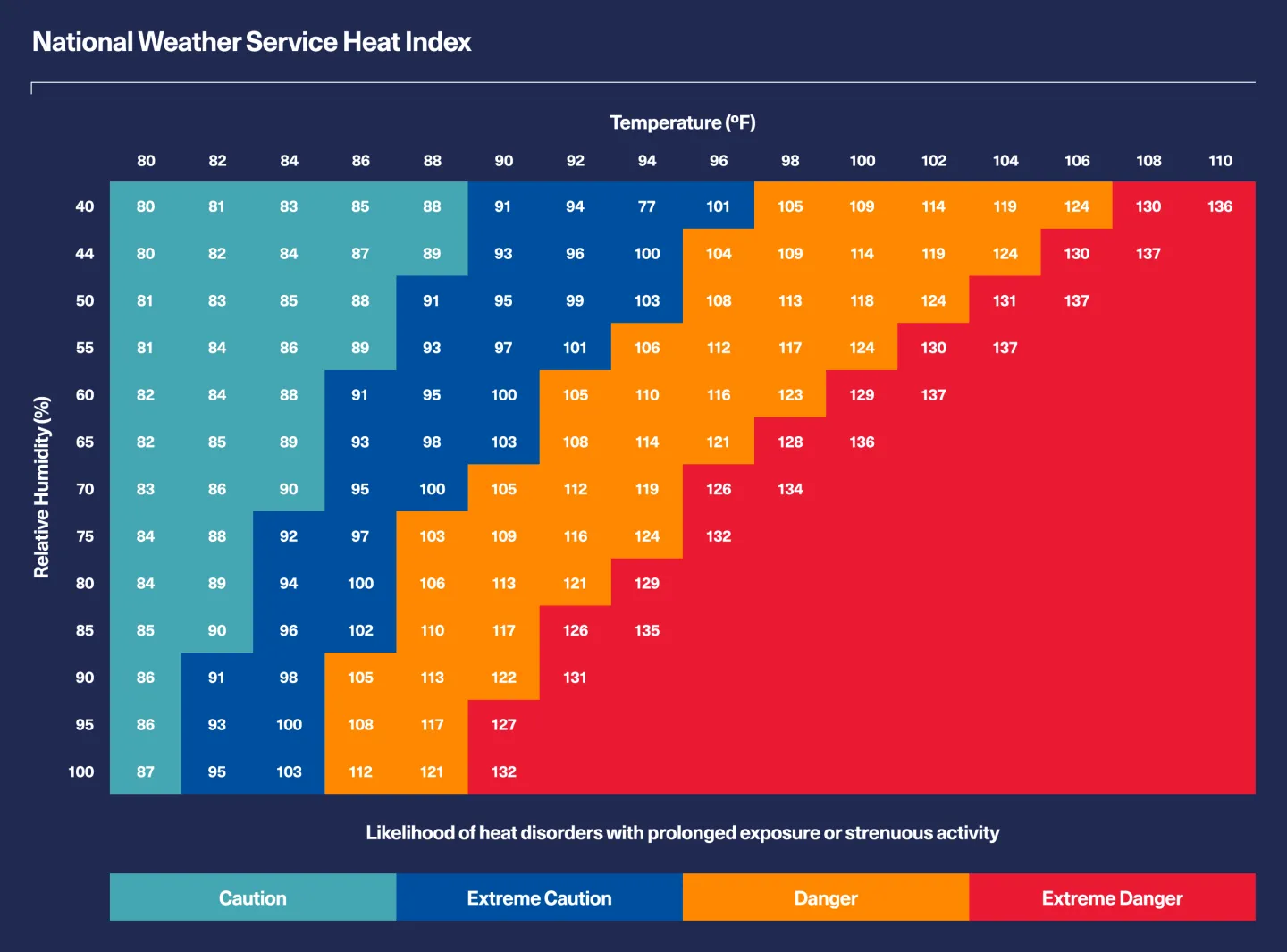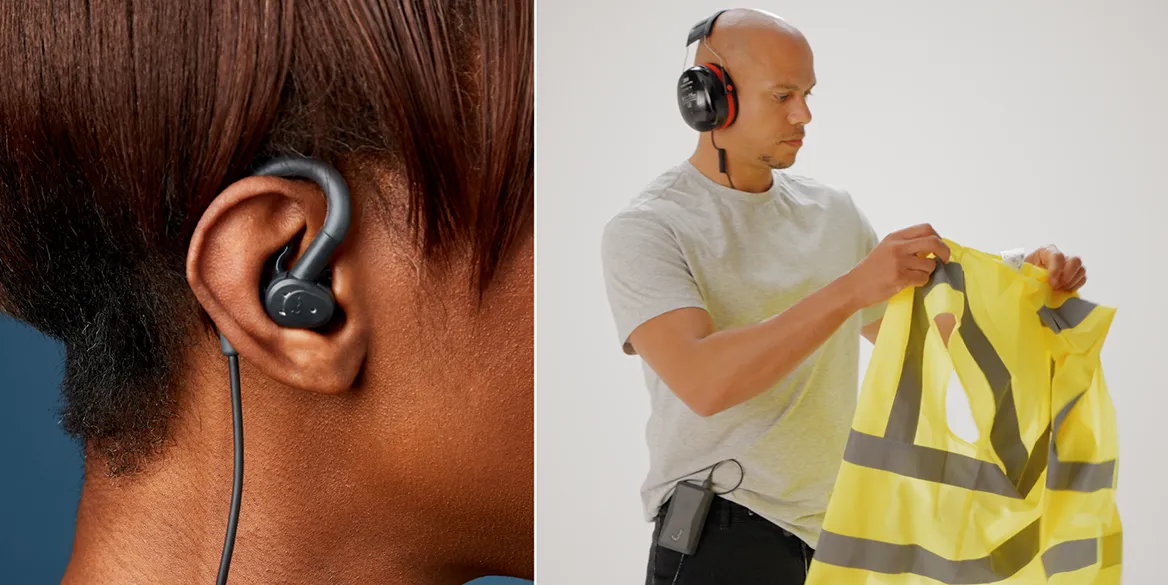Managing Heat Stress in the Workplace: A Guide

According to the Bureau of Labour Statistics, heat exposure causes over 170,000 work-related injuries and more than 2000 fatalities every year. As temperatures continue to increase each summer, these numbers are expected to rise unless organisations implement effective strategies to continue safeguarding their employees. While the risks are often heightened during the summer months, certain industries such as foundries and smelting operations, mining exploration and bakeries are faced with heat stress issues all year round.
Understanding the concept of heat stress is crucial in managing employee safety during the warmer months and beyond. This comprehensive guide aims to delve into the intricacies of heat stress and explore practical solutions for managing it in the workplace.
What is workplace heat stress?
Workplace factors that contribute to heat stress
Managing heat stress in the workplace
How does technology help tackle workplace heat stress?
Frequently asked questions (FAQs)
What is workplace heat stress?
In order for us to be healthy and function correctly the human body thermoregulates. This is how the body maintains the core body temperature between 36.5°C / 97.7°F and 37.5°C / 99.5°F. When exposed to higher temperatures excess heat is stored in the body. This hinders the body’s ability to effectively regulate its internal temperature by getting rid of the excess heat, which results in heat stress.
In the workplace, the risks of heat stress can be significantly heightened, especially in industries where employees are regularly exposed to high temperatures and are required to complete physically demanding tasks. This poses many risks as physical and mental capabilities are compromised, which results in decreased productivity, increased errors, and incidents on the job. While heat stress in the workplace can have damaging effects on the short and long term health and wellbeing of employees, the implications can extend beyond those directly involved in the incident.
Heat-related illnesses
When the body overheats, this can lead to heat-related illnesses that range from moderate severity to life threatening conditions. Here are some common heat-related illnesses employees can encounter in the workplace if the right strategies are not implemented.
Dehydration: According to the Centers for Disease Control and Prevention, daily fluid intake recommendations can vary depending on age, sex, race or ethnicity. When we are exposed to increased temperatures the body sweats, as the evaporation of sweat is the body’s main mechanism to cool itself. When the body releases more fluid than it consumes it can lead to dehydration causing extreme thirst, irritability, confusion, fatigue and feelings of dizziness and being light headed.
Heat exhaustion: When temperatures rise this is often one of the most common heat-related illnesses. This is a result of the body’s core temperature going above the normal range, leading to symptoms such as headaches, dizziness, nausea and fatigue.
Heat rash: Commonly known as prickly heat, this can often be a clear indication of an employee suffering from heat stress. If an employee remains in the same hot environment it can quickly spread to larger areas of the body or become infected, making it extremely uncomfortable and difficult to focus on the tasks at hand.
Heat cramps: These are painful muscle spasms targeted at the muscles which are used to perform the work required. While the employee may be trying to stay hydrated, heat cramps often occur due to the amount of salts (electrolytes) lost in the body from sweating.
Sunburn: When the skin is exposed to direct sunlight without the right amount of protection it can lead to an inflammatory reaction to the ultraviolet (UV) radiation which damages the skin’s outermost layer. This is what we know as ‘sunburn’. This can vary in severity depending on the individual, with some people requiring hospitalisation and having long term damage long after the sunburn fades.
Heat syncope: This is a feeling of heat-induced dizziness and fainting as a result of an insufficient flow of blood to the brain temporarily while a person is standing. This can also be triggered by intense physical activity for 2 hours or more before fainting. While it can happen to anyone, employees who have not acclimated to the heat and/or standing continuously can be more susceptible.
Heat stroke: This is the most severe heat-related illness. In medical terms, heat stroke is defined as a core body temperature that exceeds 40°C / 104°F, that results in complications involving the central nervous system after exposure to high temperatures. Symptoms can include confusion, seizures, loss of consciousness, and organ damage. It’s extremely important to recognise the signs early in order to provide intervention as delays can be fatal.
Workplace heat stress trends
In recent years, heat stress has emerged as a significant concern for organisations across numerous industries. With the effects of climate change intensifying, extreme heat events and escalating temperatures have become more frequent and intense. This trend has led to an increased risk of heat-related incidents in the workplace, which has resulted in long-term health implications for employees and productivity losses for organisations.
A publication by the International Labour Organisation reports that, by 2030, more than 2% of the total working hours worldwide is projected to be lost every year, as a result of it being too hot to work or the need to slow down to combat the risk of heat stress. In Southern Asia and Western Africa it’s predicted that productivity loss may be even greater, reaching 5%. With such compelling figures there’s no wonder why employers are addressing heat stress in the workplace and implementing strategies to protect their employees, while also maximising productivity.
Another notable trend is the implementation of comprehensive heat stress management programmes. These programmes have progressed beyond basic safety measures and focus on proactive measures to prevent heat-related incidents and, in severe cases, fatalities. Organisations are conducting risk assessments to identify areas prone to heat stress, monitoring ambient temperatures and weather conditions, and providing training and education to employees to recognise the early signs and symptoms of heat-related illnesses.
Workplace factors that contribute to heat stress
It is clear organisations are moving in the right direction and having relevant conversations to address the concerns of heat stress; however, understanding the contributing workplace factors is also important. Many personal factors can place individuals at a greater risk, but by identifying the hidden risks, organisations can ensure they take proactive measures to mitigate these. Key sources of heat stress are discussed below.
- Environmental conditions: The environment in which an employee works plays a crucial role in the risk of heat stress. High temperatures, humidity, and poor air circulation can create a breeding ground for heat-related illnesses. Outdoor workers, such as construction or agricultural labourers, are particularly vulnerable due to direct exposure to sunlight and lack of shade. Indoor environments can also pose risks, especially in factories, foundries, or kitchens where heat-generating machinery and processes are present. Inadequate ventilation exacerbates the problem, trapping heat and reducing the body’s ability to cool down effectively.
- Physical exertion: Engaging in physically demanding tasks increases the body’s heat production, putting workers at a higher risk of heat stress. Jobs that involve heavy lifting, prolonged standing, or repetitive movements intensify the metabolic heat generated by the body. This added heat, coupled with environmental factors, can lead to a dangerous rise in core body temperature.
- Personal Protective Equipment (PPE): Wearing PPE such as gloves, masks, or protective clothing can also trap excess heat and moisture inside. This makes it far more challenging for the body to regulate its temperature. While PPE is designed to protect workers from outside threats, it’s also important for organisations to understand and address the burden that PPE can impart on the body.
- Work rest schedules / rest breaks: The timing and duration of work and rest periods are vital factors when managing heat stress. In industries where continuous operations are necessary, workers can be exposed to high temperatures for extended periods. Insufficient breaks or inadequate recovery time between shifts prevent employees from rehydrating and cooling down. Similarly, night shift workers may face additional challenges, as they are exposed to high temperatures during the day while trying to sleep, compromising their important rest and recovery.
Managing heat stress in the workplace
At least 11 workers are seriously injured or die from heat stress every day in the US. This is far more common than people realise; however, heat-related illnesses are completely avoidable if the right strategies are implemented to manage it in the workplace. These can include hydration, rest breaks and the below.
- Engineering controls: Some organisations are introducing a number of engineering controls in order to reduce heat stress hazards. These include installing cooling systems or providing areas with more shade or shielding from radiant heat sources (i.e. furnaces or hot machinery), using power tools to reduce manual labour and adjusting work schedules to minimise heat exposure during intense periods throughout the day.
- Training: Knowledge is power. Understanding the signs of heat-related illnesses can be critical when every second counts. Organisations who provide employees with the adequate training to identify the signs and methods to help reduce core body temperature can prevent incidents and save lives.
- Acclimatisation: According to NIOSH heat acclimatisation is the improvement of the body’s tolerance to heat that develops gradually by increasing exposure to the environment or duration of tasks performed under those conditions. Investigations have shown that 80% of the reported cases of heat-related illnesses occurred within the first four days of employment. It is evident that acclimatisation is extremely important. A guide to understanding heat acclimatisation within your organisation will be invaluable.
Heat stress calculators
Along with heat stress management strategies, a number of organisations are also using heat stress calculators. Heat stress calculators are tools designed to assess and quantify the level of heat stress in a specific work environment.
These calculators use a combination of factors (examples below) that help to determine the heat stress index or heat load on workers;
- Temperature
- Humidity
- Air velocity
- Radiant heat.
However, it is important to recognise that there are limitations that can affect their reliability. Heat stress calculators do not consider individual responses and variations in heat tolerance or the impact of PPE. They also often overlook other factors (listed below) that can influence heat stress levels:
- Intermittent work
- Physiological responses
- Dynamic changes in the work environment
NWS Heat Index
Some organisations find that understanding the National Weather Service (NWS) Heat Index can be beneficial as an additional tool to supplement heat stress assessments.
The NWS Heat Index, also known as the “apparent temperature,” provides a quick reference guide to determine how hot it feels outside based on the current air temperature and relative humidity.
The table displays various heat index values, which indicate the level of discomfort and the potential risk of heat-related illnesses. By using the NWS Heat Index table, people can assess the potential dangers of heat exposure and take appropriate precautions, such as seeking shade, staying hydrated, and avoiding strenuous activities during times of high heat index values.
It is important to remember that the table provides general guidelines. Similar to the heat stress calculator, the NWS Heat Index table does not take into factors such as individual sensitivity to heat.

How does technology help tackle workplace heat stress?
The evolution of wearable technology is transforming the way organisations tackle heat stress, with smart safety solutions like Bodytrak leading the way as a reliable and innovative approach.
Advanced sensors and real-time monitoring capabilities ensure Bodytrak can provide critical insights into an individual’s physiological responses to the workplace environment, such as increased temperatures, and trigger alerts when thresholds have been exceeded. Both the user (via audio prompts) and supervisors (via the Dashboard, SMS and email) receive the alerts, enabling intervention and/or support to be deployed when required.
Bodytrak’s ability to measure core body temperature, heart rate and physiological strain index (PSI) offers a comprehensive understanding of an individual’s response to increased temperatures. While other tools do not take into account factors like an individual’s thermal sensitivity and intermittent work patterns, Bodytrak provides a solution that monitors each worker and their individual response to internal and external workplace stressors.
Unlike traditional monitoring methods, Bodytrak provides accurate and reliable data, making it a more effective solution for managing heat stress. Through in-ear sensors it directly measures core body temperature, which is a more accurate indicator of heat stress than external skin temperature measurements or estimations due to its proximity to the hypothalamus (control centre for core body temperature).
The wearable design of the Bodytrak device provides convenience and comfort for users, allowing them to carry out their tasks without interference. The device is non-invasive and easy to use, ensuring minimal disruption to daily operations while providing continuous physiological monitoring. Along with providing accurate monitoring, Bodytrak can benefit organisations as it is a versatile, multi-functional device. In addition to preventing heat-related illnesses, Bodytrak can also monitor fatigue and noise exposure, eliminating the need for multiple disparate safety solutions.
Implementing technology like Bodytrak that provides multiple physiological responses and safety measurements is extremely beneficial. Organisations can simplify the monitoring process, reducing the need for employees to wear multiple devices whilst streamlining data collection. In addition, it provides a complete overview in an easy to digest format, allowing for better-informed data-driven decisions, implementing targeted interventions, and ensuring the well-being and safety of their workforce.

Bodytrak Device
Versatile multi-function device that prevents heat stress alongside providing geolocation, geofencing and user activated SOS alarm.
The CommPack is lightweight and has a smaller footprint than a standard smartphone.
Frequently asked questions (FAQs)
How do you manage heat stress in the workplace?
Organisations can manage heat stress in the workplace by implementing key strategies such as providing ventilation, access to cool drinking water, scheduling frequent rest breaks, promoting heat-appropriate personal protective equipment (PPE), conducting heat stress training, and monitoring the work environment.
Wearable technology like Bodytrak can further enhance heat stress management by providing accurate and real-time data of each individual’s physiological response to workplace stressors such as increased temperatures. This data allows for individualised monitoring and alerts to be triggered to the user and supervisor to prevent incidents and provide urgent assistance when required.
By leveraging the power of wearable technology like Bodytrak, employers can make data-driven decisions and proactively create a safer and healthier working environment that is tailored to the individual needs of their employees, revolutionising the way heat stress is managed in the workplace.
What should you do in the event a coworker is suffering from heat exhaustion?
When it comes to heat-related illnesses, every second counts. If a co-worker is suffering from heat exhaustion, it is important to take immediate action. Move them to a cooler area, if they’re conscious and able to swallow, provide them with fluids to rehydrate, loosen or remove excess clothing especially PPE, and use a fan or wet towels to help them cool down if they are unable to access an air conditioned space.
It is imperative to seek medical assistance and continue to monitor the condition closely until professional medical support arrives.
What are administrative controls for heat stress?
Administrative controls for heat stress involve implementing organisational policies and procedures to manage heat-related risks. These controls may include adjusting work schedules to avoid peak heat hours, providing regular rest breaks in shaded or air-conditioned areas, conducting heat stress training for employees, and implementing acclimatisation programmes for new or returning workers. These measures aim to minimise heat exposure and promote a safer work environment during periods of high temperatures.
Conclusion
Organisations around the world are responsible for managing heat stress and ensuring the necessary steps are taken to protect their employees. Heat-related illnesses can have severe consequences, ranging from dehydration and heat exhaustion to life-threatening conditions like heat stroke.
Understanding the contributing factors can help organisations formulate an effective strategy. Technology like Bodytrak can help monitor and manage heat stress by providing real-time data on individuals’ physiological responses to workplace stressors. Insights are also available to help assess engineering and administrative controls and the effectiveness alongside other PPE.
By implementing holistic strategies supplemented with wearable technology, organisations can proactively protect their employees from heat-related illnesses, minimise productivity losses, and create a culture of safety in the workplace.




